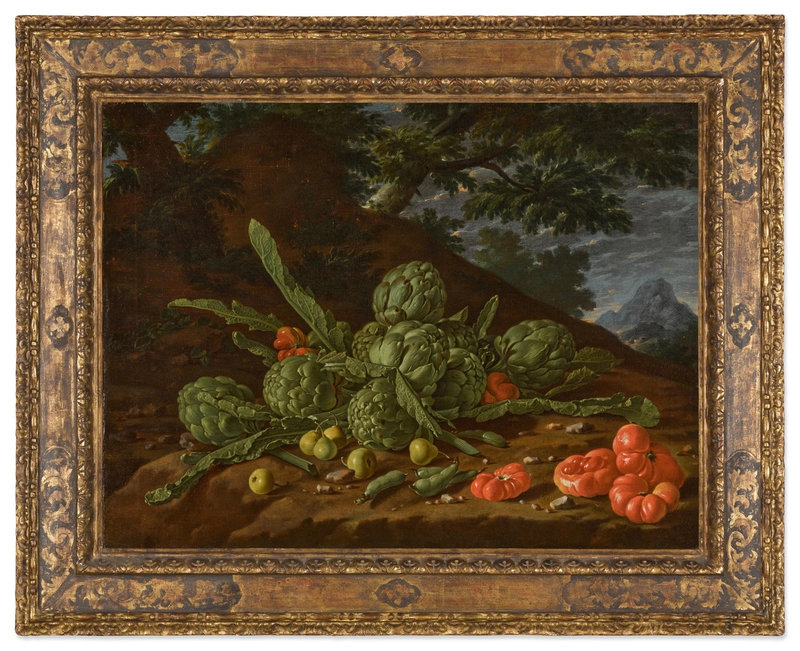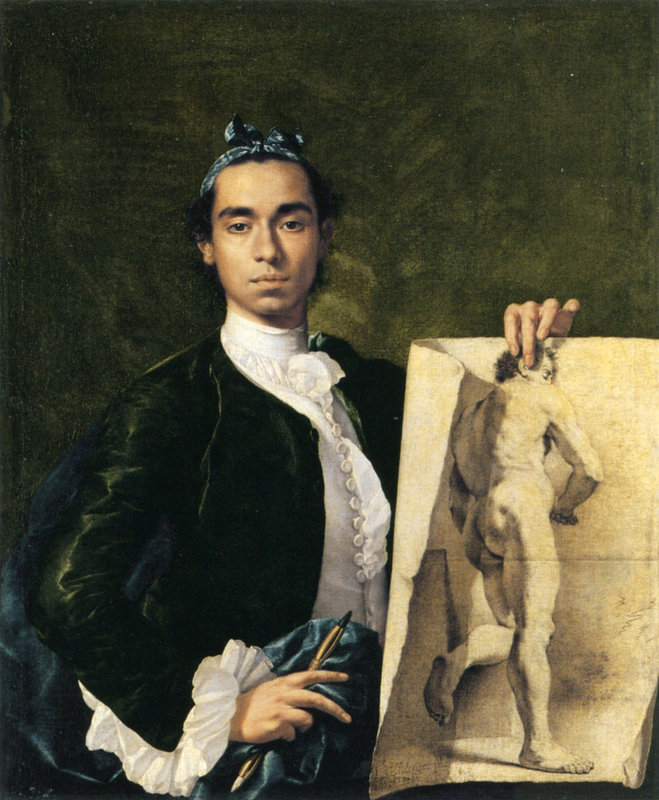Luis Meléndez (Naples 1716 - 1780 Madrid), Still Life of Artichokes and Tomatoes in a Landscape
Lot 338. Property from the Estate of Herman Schickman. Luis Meléndez (Naples 1716 - 1780 Madrid), Still Life of Artichokes and Tomatoes in a Landscape, signed on small stone at right: L. Mz , oil on canvas; canvas: 62.4 by 82.7 cm; framed: 85.5 by 106.4 cm. Lot Sold 2,056,500 USD (Estimate 2,000,000 - 3,000,000 USD). © Sotheby''s 2024
Provenance : Edward Sackville-West (1901-1965), 5th Baron Sackville;
By whose estate sold ("The Property of the late Lord Sackville"), London, Sotheby’s, 16 March 1966, lot 71;
Where acquired by Hallsborough Gallery, London;
From whom acquired by Herman Shickman, by 1970.
Literature: "Bibliografía. Mercado de Arte,” in Archiveo Español de Arte 39, no. 154-55 (1966), p. 256, no. 210, reproduced pl. III;
E. Tufts, A Stylistic Study of the Paintings of Luis Meléndez, doctoral dissertation, New York 1971, p. 183, cat. no. 58, reproduced fig. 53;
J.J. Luna, Luis Meléndez: Bodegonista español del signlo XVIII, Madrid 1982, p. 31, reproduced;
E. Tufts, “Luis Meléndez, Still-Life Painter ‘Sans Pareil,’” in Gazette des Beaux-Arts (November 1982), p. 163, cat. no. 82, reproduced;
E. Tufts, Luis Meléndez: Eighteenth-Century Master of Spanish Still Life, with a Catalogue Raisonné, Columbia, Missouri 1985, p. 103, cat. no. 81, reproduced p. 185, pl. 81;
E. Tufts and J.J. Luna, Luis Meléndez: Spanish Still-Life Painter of the Eighteenth Century, exhibition catalogue, Dallas 1985, pp. 100-101, cat. no. 24, reproduced pp. 4, 101;
N.A. Mallory, “Dallas, Luis Meléndez,” in The Burlington Magazine 985 (April 1985), p. 260;
J. Brown, “Review of ‘Luis Meléndez. Eighteenth-Century Master of the Spanish Still Life with a Catalogue Raisonné," in Art in America 73 (October 1985), p. 17;J.J. Luna, “America en los bodegones de Luis Meléndez,” in Madrid en el context de lo hispánico, Madrid 1994, p. 537
J.J. Luna, Los alimentos de España en la pintura de bodegones de Luis Meléndez, Madrid 1995, p. 46, reproduced;
W.B. Jordan and P. Cherry, Spanish Still-Life from Velázquez to Goya, exhibition catalogue, London 1995, pp. 161-162, 216, cat. no. 59, reproduced p. 162;
R. Kasl and S.L. Stratton, Painting in Spain in the Age of Enlightenment. Goya and His Contemporaries, exhibition catalogue, New York 1996, pp. 268-270, cat. no. 58, reproduced pp. 122, 268;
P. Cherry and J.J. Luna, Luis Meléndez: Still Lifes, exhibition catalogue, Dublin 2004, p. 108, under cat. no. 14, reproduced fig. 64;
P. Cherry and J.J. Luna, Luis Meléndez: Bodegones, exhibition catalogue, Madrid 2004, p. 180, under cat. no. 13, reproduced fig. 95;
P. Cherry, Luis Meléndez: Still-Life Painter, Madrid 2006, pp. 150, 154, 540, cat. no. 81, reproduced p. 461;
G.A. Hirschauer and C.A. Metzger, Luis Meléndez: Master of the Spanish Still Life, exhibition catalogue, Washington, D.C. 2009, pp. 152-155, cat. no. 28, reproduced pp. 153, 155.
Exhibited: Amsterdam, Historisch Museum, 1970;
Raleigh, North Carolina Museum of Art; Dallas, Meadows Museum; New York, National Academy of Design, Luis Meléndez: Spanish Still-Life Painter of the Eighteenth Century, 12 January - 1 September 1985, no. 24;
London, National Gallery, Spanish Still-Life from Velázquez to Goya, February - May 1995, no. 59
Indianapolis Museum of Art; New York, Spanish Institute, Painting in Spain in the Age of Enlightenment. Goya and His Contemporaries, 23 November 1996 - Spring 1997, no. 58;
Washington, D.C., National Gallery of Art; Los Angeles County Museum of Art; Boston, Museum of Fine Arts, Luis Meléndez: Master of the Spanish Still Life, May 2009 - May 2010, no. 28;
New York, Metropolitan Museum of Art, long term loan, 1999 - 2018.
Note: One of the most important Spanish artists of the eighteenth century, Luis Meléndez painted over 100 still lifes throughout his career. The present painting, however, is one of only six large-scale still lifes that are set within outdoor settings. With its pile of just ripening artichokes, scattered pea stems and glowing red tomatoes artfully arranged within a landscape, the subject is ordinary fare, not food for a banquet, set directly on the ground before a group of dark trees, with a small hilly landscape painted beyond to the right. Even with its grand size and dramatic landscape, the painting displays the graceful simplicity that characterizes Meléndez's work and is so appealing to the modern viewer, raised on the beautifully constructed compositions of Cézanne and Matisse.
Meléndez came from a family of artists. His father, Francesco Antonio Meléndez (1682-1758), was a royal painter trained in Madrid; upon completing his studies in 1699, he moved to Italy and traveled throughout the country before settling in Naples. It was there that he met and married Maria Josefa de Durazo y Santo Padre Barrille y Rodriguez (c. 1685-1751) and bore three children, the second of which was Luis. The family left Naples and returned to Spain in 1717. Francesco Antonio developed a successful career as a miniature court painter in Madrid and was named as the first Master Director of Painting of the Provisional Academy of Arts, which began in 1744.
Luis Meléndez originally set out to be a figure painter and studied under the French royal portraitist Louis-Michel Van Loo while he was in Madrid. Perhaps with his father’s influence, in 1744 he left van Loo’s studio to become one of the first students of the Provisional Academy. While a student there he completed a Self-portrait (fig. 1) in 1746 which shows him proudly displaying a black chalk drawing of a muscular nude figure, exhibiting his great ambitions as a young artist. Unfortunately, his dreams of being an academic figure painter were foiled when Meléndez and his father were expelled from the Provisional Academy of Arts in 1748 due to souring relations with the leadership, an ironic situation as Francesco Antonio had helped to found the Academy. Thus the young Meléndez became a miniature painter, and also turned to what was then considered the minor genre of still life.
Fig. 1 Luis Meléndez, Self-portrait, oil on canvas, Paris, Musée du Louvre, inv. n°RF2537.
Still life painting in Spain had virtually disappeared between the end of the seventeenth and beginning of the eighteenth centuries. What interest there was in the subject was satisfied by importing pictures and sometimes the artists themselves from Italy. From 1748, the year he left the Academy, to 1752, Meléndez lived in Rome and Naples, where he was exposed to contemporary still lifes and well as the work of the famous artists of the preceding century. The Neapolitan Giacomo Nani (1698-1770), whose still lifes show a similar simplicity and concentration on mundane food stuffs and table ware, is often cited as an influence on him. The earliest dated still lifes by Meléndez are from 1759 and 1760, once he had returned to Madrid, though their quality is so high it is hard to believe this was his first foray into the subject matter.
In the end, Meléndez's originality and skill set him apart from his contemporaries in Spain and Italy. Despite the humble nature of the objects portrayed, his still lifes have a remarkable grandeur and monumentality. Here in the Still Life of Artichokes and Tomatoes in a Landscape, as in most of his paintings, he chooses a low vantage point and sets the objects very close to the picture plane. He arranges the artichokes carefully on top of one another, mixing in other greens to vary the textures; two tomatoes that are just turning red are snugly placed into the pile. A few small pears and some pea pods are scattered in front of the pile and four large, juicy tomatoes balance the composition in the right foreground. The exact placement of the objects is crucial and carefully calibrated. Melendez paints the various vegetables and fruits from every direction, so we can see the wonderful, sculptural curves and sharp ridges of the artichokes from all sides, and how the segments of the tomatoes bulge out and then curve back in toward the stems. Even the pears, which otherwise would be overlooked, are shown in various positions, standing up elegantly as well as toppled over and seen from the bottom, with delicate stems holding them up. He differentiates the smooth surfaces of the tomatoes and pears from the tough green leaves of the artichokes and the crinkling, stiff leaves of the greens, and while everything appears to be just piled together, it is all carefully drawn out in a distinct diagonal composition, pulling the viewer’s eye from the top of the green leafs down to the curving lines of the swollen tomatoes.
Sotheby's. Master Paintings & Sculpture Part I, New York, 1 February 2024

/https%3A%2F%2Fprofilepics.canalblog.com%2Fprofilepics%2F1%2F0%2F100183.jpg)
/https%3A%2F%2Fstorage.canalblog.com%2F03%2F02%2F119589%2F96711876_o.jpg)
/https%3A%2F%2Fstorage.canalblog.com%2F11%2F31%2F119589%2F94773502_o.jpg)
/https%3A%2F%2Fstorage.canalblog.com%2F20%2F83%2F119589%2F94772815_o.jpg)
/https%3A%2F%2Fstorage.canalblog.com%2F26%2F72%2F119589%2F75604929_o.jpg)
/https%3A%2F%2Fstorage.canalblog.com%2F59%2F60%2F119589%2F26458628_o.jpg)






/http%3A%2F%2Fstorage.canalblog.com%2F66%2F02%2F119589%2F122298491_o.jpg)
/http%3A%2F%2Fstorage.canalblog.com%2F08%2F97%2F119589%2F120869508_o.jpg)
/image%2F1371349%2F20240503%2Fob_e1ad63_tidqkdqp.jpeg)
/image%2F1371349%2F20240502%2Fob_bd3c09_telechargement-4.jpg)